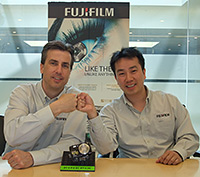The Fuji Guys Answer More SavvyMom Reader Questions
 We had so many great questions from our SavvyMom readers on how to take great pictures of your family that the Fuji Guys offered to answer more of your questions. Read the first round of questions and get more tips below.
We had so many great questions from our SavvyMom readers on how to take great pictures of your family that the Fuji Guys offered to answer more of your questions. Read the first round of questions and get more tips below.On a digital camera how do you make the main subject clear but the background blurred?
Janna L. from Delta, BC
On a digital SLR, it is very simple to create a shallow depth of field due to the larger size of the image sensor. With a compact digital camera and its much smaller image sensor, achieving the same effect is much more difficult and at times be a little tricky. Here are some tips;
- Try shooting portraits with the “Macro” mode enabled for some shots. This will cause the camera to change the focus range to be very small, so anything before or after this focus distance will be “out of focus”.
- Instead of taking a wide-angle shot of your subject, step further back and then use the cameras zoom to get closer. This can help you achieve a shallow depth of field and cause the background to be blurred.
- On some Fuji camera models, there is a feature called “Pro Focus”. Pro Focus uses multi-frame technology to create an image with a perfectly focused subject against an out-of-focus background.
Every time I take a picture, it ends up blurry. Are there cameras that allow for hands that shake?
Kari L. from Oakville, ON
“Blurry” images can be caused by the following:
- Poor lighting
- If the lighting in the area is not bright enough, the camera will use a slower shutterspeed to capture the proper exposure. Generally, if the shutterspeeds fall below 1/60s, then images will be “blurred” due to either the subject moving and/or the camera not being held steady enough
- To prevent shake, you can force the flash on the camera to fire or try to increase the ISO/Sensitivity on the camera in order to allow the camera to achieve a faster shutterspeed.
- Camera Shake
- General, camera shake is caused when a slower shutterspeed is used by the camera. Because the shutterspeed is very slow, any movement to the camera will be captured which will show up as “blur” in the image.
- Some cameras have an image stabilization mechanism to counter -act the hand motion or “camera shake”. This helps to reduce the likeliness of “blur”; however, if you are shooting in a low light situation, any moving subjects in your scene will still be blurred. Image stabilization can only help to reduce camera shake and not motion blur due to slower shutterspeeds.
Fuji offers several models with “Image Stabilization” to help this camera shake. Generally, the long zoom models will more than likely offer this as with these style cameras, the slight movement of the camera while at full zoom will be magnified.
Some models to look for are: S1800, HS10, JZ310/300, F80EXR, F300EXR.
 Do you have any tips on shooting in extreme heat and humidity? I always find that when we go to Mexico or somewhere hot our pictures turn out foggy looking.
Do you have any tips on shooting in extreme heat and humidity? I always find that when we go to Mexico or somewhere hot our pictures turn out foggy looking.
Kelsey P. from Calgary, AB
The foggy look is most likely due to the change in temperature when you take the camera from one climate to another (Cold to Hot or Hot to Cold). Condensation may happen on the lens causing this “foggy” look. You should allow the camera to “acclimatize” itself to the change in the environment before you go and take a photo with the camera.
What’s the best way to shoot macro pictures in dark?
Saurabh G. from Mississauga, ON
The best way to achieve macro photos in the dark is to use the built-in flash. If you find the subject being washed out due to the flash, using a separate light source to shine on the subject will be much better. Ideally, using a tripod is highly recommended for this situation. Sometimes, if it is not too dark, using a silver reflector (or even tin foil) to cast light from the sun onto a subject will give you a more subtle appearance.
How do I get the best pictures during a school concert? (i.e. dark auditorium, poor lighting/back lighting on stage, distance)
Maryanne M. from Toronto, ON
I would suggest using a flash while ensuring the ISO/Sensitivity is set to at least 400 or higher. Generally however, you will be too far back for the flash to be very effective so here is what to do.
- Change the ISO/Sensitivity to 400, 800, or 1600. Try to use the lower setting first to see if the shutterspeed is at least 1/60s. Then start changing the ISO until to achieve at least 1/60s for shutterspeed.
- Turn off the “Flash”. The flash will not be very effective if you are far away from the stage.
- Change the “Metering” on the camera to “Spot” metering. There is normally good lighting focused on the stage. By using Spot metering, the exposure will be adjusted to where you aim the camera (in the centre of the frame). This will also help with getting the correct exposure when there is backlighting from the stage.
 How do you get a clear picture of something really close up, such as a beautiful butterfly on a flower?
How do you get a clear picture of something really close up, such as a beautiful butterfly on a flower?
Rae B. from Creston, BC
Most cameras have a “Macro” mode. This is usually identified by a little “flower” icon. In this mode, the camera changes the focus range to be normally in the range of 5–10 cm. Some cameras also have a Super Macro that will allow you to get as close as 1 cm from the subject. You can enable this mode and have the camera very close to the subject to capture the photo. In fact, most of the sharpest images come from using the “Macro” mode.
On some long zoom cameras, you can also use the “macro” feature while zooming close to the subject. This can help with taking close-up photos of subjects like butterflies which may fly away if you physically move the camera closer.
Do you recommend placing the focus of the picture (i.e. my son) off centre in a photo or is a centered approach best?
Cathy F. from Toronto, ON
The average photo generally has the subject right in the centre of the photo. Although there is nothing wrong with this, the photos may appear a little “boring”.
Photographers use what is called the “Rule of Thirds” to help frame subjects in the photo. The rule states that an image should be imagined as divided into nine equal parts by two equally-spaced horizontal lines and two equally-spaced vertical lines, and that important compositional elements should be placed along these lines or their intersections.
The “rule of thirds” helps with composition; however, this rule may not work in all situations. By positioning your subject in different areas of the photo instead of the centre, this can be more creative.
For instances, if your subject is looking left in the photo, then position the subject to be at the far right. If your subject is running to the right, frame the shot so your subject is at the left of the photo to give a sense of motion and direction.
Which camera is best for water, fast motion and mud. I am pregnant with our first baby and those are the key three things that I am going to require when purchasing a camera. Babies love swimming in the pool, getting dirty and never stop moving once they learn how to walk. It’ll be a great challenge!!! : )
Nicole Z. from Port Coquitlam, BC
The Fujifilm XP10 is the top selling ‘everything proof’ camera in the Canadian market. This camera also offers HD video with a “one touch” movie recording feature. This camera would be ideal for your situation.
How can I get a professional photography look from a Fujifilm camera?
Mandy S. from Langdon, AB
Generally, professional looking photos have the following;
- Shallow depth of field (background is blurred)
- Using the tips from the earlier question on this subject of getting blurred background with a compact camera can help achieve this
- If you are using a SLR style camera, shooting in the aperture priority mode and selecting a large aperture (small number)
- Photos are very colourful or just black & white.
- Use the “Chrome” mode found on Fuji cameras to increase the colour saturation on the photo.
- There is also a “B&W” mode too.
- Main subject in the photo look very sharp.
- When taking photo of a subject, try focusing the camera on the “eyes” of the person.
- Increase the “sharpness” setting on the camera in the menu system.
- Subject is not in the centre of the frame.
- Try using the “rule of thirds” to frame and compose your photo. This can really help to make the photo stand out
- Use the “Grid line” display found on all Fuji cameras to help with framing your photo.
Saying all this, most professional photos are normally edited using a photo editing/retouching program like “Photoshop” to achieve the desired look.
 Would you share your top 10 tips for family picture taking? We can then print them out and keep them with the camera case! Better pictures from now on!
Would you share your top 10 tips for family picture taking? We can then print them out and keep them with the camera case! Better pictures from now on!
Julie E. from Monkon, ON
- Choose the right outfit
- Select neutral colour outfits as they will put more focus on the people and their faces versus the clothing.
- We don’t want to outdate the photo by wearing something too flashy.
- Avoid extreme colours, prints, patterns, and logo.
- Decide on the clothing before the day you would like to take the photos.
- Subject positioning
- It’s a family portrait so don’t be afraid to get close to each other. This gives a better sense of warm and comfort.
- Refrain from anyone tilting their head on a family member’s shoulder.
- Position family members in a memorable way. Not like a lineup.
- With lots of family member, create smaller clusters of people in the frame. Have some sitting down, while others stand further back.
- Location
- Choose a good location where you can get a little natural light coming into the photo.
- A location that has importance to the family is ideal. If the family likes to sail, setup the portrait at the docks or on the deck of the sail boat. If the family enjoys the outdoors, take it at the park.
- Have the correct camera settings
- Try to shoot with a wide-open aperture on your camera to allow the background to be “blurred”, giving you a shallow depth of field. Unlike DSLR cameras, it may be very difficult to get the background out of focus with a compact camera even if the camera has manual controls.
- If you are shooting outdoors with good lighting, you may still need to force the flash to remove any unwanted shadows in the face.
- Have the right equipment
- Use a tripod to ensure you get a steady and leveled photo.
- Use an external flash if possible. Aim/bounce the flash towards the ceiling to help soften the effects of the flash on the subjects face when shooting indoors.
- Ensure the family is relaxed
- This will allow for the family’s personality to shine in the photo.
- Your photos will look more natural.
- Show relationship
- Father holding the hand of a child (focus on the point). You don’t have to include faces in the photo.
- Be creative and look for ways to express relationships within the photo.
- Position by ages
- Instead of positioning the subject from right to left or left to right, why not try positioning their faces one over the other in a vertical way.
- Only take photos of their faces and concentrate on the subject.
- Take candid photos
- Snap photos as you get into position.
- Sometimes, the real photos are not setup.
- Digital is great—you can take as many photos as you want.
- Look for warm moments during your photos.
- When the family is talking, they are comfortable standing around, take those types of photos instead.
- Fill the Frame
- If you are taking a photo, try to concentrate on the subject by zooming in instead of getting the furniture in the shot.
- Avoid cluttering the photo with objects which do not play any important role in the photo.













